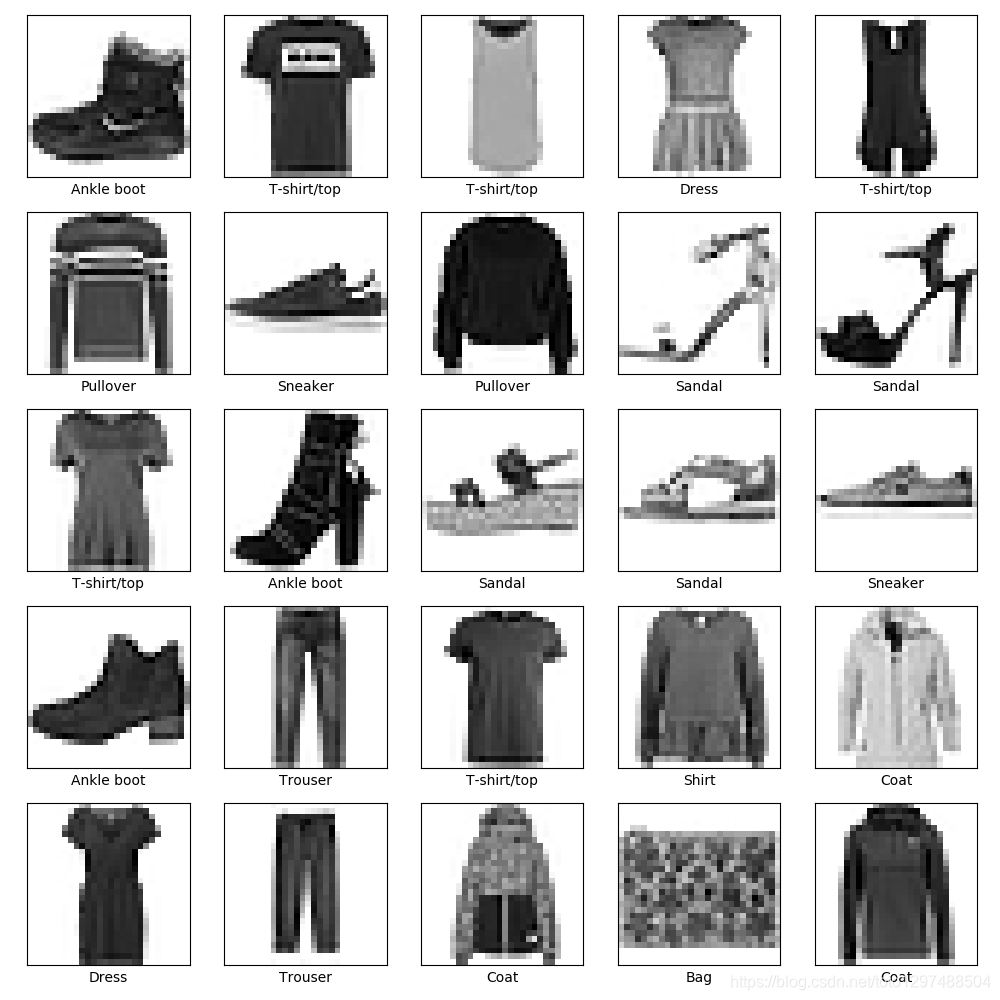1.3.1.基本图像分类
翻译自:https://tensorflow.google.cn/tutorials/keras/classification
该指南训练一个神经网络模型来对服装图像进行分类,像脚底运动鞋和衬衫。如果你不理解所有的细节也没有关系。这个是一个完成的TesorFlow程序的快速的概述。
指南中使用 tf.keras,这是一个高阶API,用于在TensorFlow中构建和训练模型。
# TensorFlow and tf.keras
import tensorflow as tf
from tensorflow import keras
# Helper libraries
import numpy as np
import matplotlib.pyplot as plt
print(tf.__version__)
输出结果:
2.2.0
1.3.1.1.导入Fashion MNIST数据集
fashion_mnist = keras.datasets.fashion_mnist
(train_images, train_labels), (test_images, test_labels) = fashion_mnist.load_data()
载入数据集返回4个NumPy数组
train_images和train_labels数组是训练集。这个数据是这个模型学习用的。
模型测试基于测试集,即test_images和test_labels数组。
这些图片是28x28的NumPy数组,像素值从0到255。labels数据集是一个整型的数组,从0到9。这些对应于图像所代表的服装类别:
| Label | Class |
|---|---|
| 0 | T-shirt/top |
| 1 | Trouser |
| 2 | Pullover |
| 3 | Dress |
| 4 | Coat |
| 5 | Sandal |
| 6 | Shirt |
| 7 | Sneaker |
| 8 | Bag |
| 9 | Ankle boot |
每个图像被映射到单个标签。因为这个类名不包含在数据集中,将它们存储在这里,以便稍后绘制图像时使用。
class_names = ['T-shirt/top', 'Trouser', 'Pullover', 'Dress', 'Coat',
'Sandal', 'Shirt', 'Sneaker', 'Bag', 'Ankle boot']
1.3.1.2.探索数据
在训练模型之前,让我们研究一下数据集的格式。下面显示训练集中有60000张图像,每张图像用28 x 28像素表示。
train_images.shape
输出结果:
(60000, 28, 28)
同样,训练接中有60000个标记值(目标值):
print(len(train_labels))
60000
每个标记值是0和9之间的整型值
print(train_labels)
输出结果是:
[9 0 0 ... 3 0 5]
在测试集中有10000张图片。同样,每幅图像用28 x 28像素表示:
print(test_images.shape)
输出结果:
(10000, 28, 28)
这个测试集包含10000个图片目标值:
print(len(test_labels))
输出结果:
10000
1.3.1.3.数据预处理
在训练网络之前,必须对数据进行预处理。 如果你检查训练集中的第一个图像,您将看到像素值在0到255的范围内:
plt.figure()
plt.imshow(train_images[0])
plt.colorbar()
plt.grid(False)
plt.show()

在将这些值输入到神经网络模型之前,将它们缩放到0到1的范围内,要做到这一点,需要将这些值除以255。重要的是,训练集和测试集的预处理方式相同:
train_images = train_images / 255.0
test_images = test_images / 255.0
以验证数据的格式是否正确,并且您已经准备好构建和训练网络,让我们从训练集中展示开始的25张图片和在它下面展示每个分类的名称。
plt.figure(figsize=(10,10))
for i in range(25):
plt.subplot(5,5,i+1)
plt.xticks([])
plt.yticks([])
plt.grid(False)
plt.imshow(train_images[i], cmap=plt.cm.binary)
plt.xlabel(class_names[train_labels[i]])
plt.show()
显示结果:

1.3.1.4.构建模型
构建神经网络需要配置模型的层,然后编译模型。
1.3.1.4.1.设置层
神经网络的基本组成部分是层。层从输入给它们的数据中提取特征。这些特征对于手头上的问题是很有意义的。
大多数深度学习都是由一些层连接在一起的。大多数层,例如tf.keras.layers.Dense,拥有在学习训练中的参数。
model = keras.Sequential([
keras.layers.Flatten(input_shape=(28,28)),
keras.layers.Dense(128,activation='relu'),
keras.layers.Dense(10)
])
在这个网络中第一层中, tf.keras.layers.Flatten,将图像格式从二维数组(28×28像素)转换为一维数组(28 * 28 = 784像素)。可以将这一层看作是将图像中的像素行展开并排列起来。这一层没有深度学习所需的参数。它只是重新格式化数据。
在像素值被flattened之后,这个网络由两个tf.keras.layers.Dense层的序列组成。它们是紧密相连或完全相连的神经层。这个第一个Dense层有128个节点(或者说神经元),第二个(也是最后一个)层返回长度为10的logits数组。每个节点包含一个分数,这个值表示当前图片属于这个10个分类中的一个的分值。
1.3.1.4.2.编译模型
在模型准备好训练之前,它需要一些更多的设置。在模型训练过程中这些参数被添加进去:
损失函数(Loss function)—这可以衡量模型在训练期间的准确性,您想最小化这个函数,以便将模型“引导”到正确的方向
优化器(Optimizer)— 这就是模型如何根据它看到的数据和它的损失函数进行更新.
Metrics—用于监控训练和测试步骤。下面的例子使用accuracy,即图片被正确分类的分数。
model.compile(optimizer='adam',
loss=tf.keras.losses.SparseCategoricalCrossentropy(from_logits=True),
metrics=['accuracy'])
1.3.1.5.训练模型
训练神经网络模型需要以下步骤:
1、将训练数据输入模型。在这个例子中,训练数据在train_images和train_labels数组中。
2、模型学习去关联图像和标签labels(目标值)
3、您要求模型对测试集进行预测。—在这个例子中,这里测试集即test_images数组。
4、验证预测是否与test_labels数组中的标签匹配。
1.3.1.5.1.Fit模型
调用model.fit方法开始训练模型。之所以这么说,是因为它使模型与训练数据“吻合”。
model.fit(train_images,train_labels,epochs=10)
输出结果:
Epoch 1/10
1875/1875 [==============================] - 3s 2ms/step - loss: 0.4957 - accuracy: 0.8262
Epoch 2/10
1875/1875 [==============================] - 3s 2ms/step - loss: 0.3758 - accuracy: 0.8652
Epoch 3/10
1875/1875 [==============================] - 3s 2ms/step - loss: 0.3373 - accuracy: 0.8766
Epoch 4/10
1875/1875 [==============================] - 3s 2ms/step - loss: 0.3112 - accuracy: 0.8859
Epoch 5/10
1875/1875 [==============================] - 3s 1ms/step - loss: 0.2968 - accuracy: 0.8896
Epoch 6/10
1875/1875 [==============================] - 3s 2ms/step - loss: 0.2820 - accuracy: 0.8956
Epoch 7/10
1875/1875 [==============================] - 3s 1ms/step - loss: 0.2700 - accuracy: 0.9002
Epoch 8/10
1875/1875 [==============================] - 3s 2ms/step - loss: 0.2577 - accuracy: 0.9030
Epoch 9/10
1875/1875 [==============================] - 3s 2ms/step - loss: 0.2497 - accuracy: 0.9060
Epoch 10/10
1875/1875 [==============================] - 3s 2ms/step - loss: 0.2385 - accuracy: 0.9106
作为模型训练,损失值和精确值被显示出来了。该模型对训练数据的准确率约为0.91 (91%)。
1.3.1.5.2.评估精确度
接下来,比较模型在测试数据集上的表现:
test_loss,test_acc = model.evaluate(test_images,test_labels,verbose=2)
print('\nTest accuracy:',test_acc)
输出结果:
313/313 - 0s - loss: 0.3528 - accuracy: 0.8791
Test accuracy: 0.8791000247001648
结果是测试数据集上的准确性比训练数据集上的准确性稍低,训练准确度和测试准确度之间的差距代表过拟合。当机器学习模型在新的、以前没有看到的输入上的表现不如在训练数据上的表现时,就会发生过拟合。过度拟合的模型“记忆”了训练数据集中的噪音和细节,从而对模型在新数据上的性能产生负面影响。欲了解更多信息,请参阅以下内容:
Demonstrate overfitting
Strategies to prevent overfitting
1.3.1.6.得出预测结果
通过训练模型,您可以使用它来对一些图像进行预测。模型的线性输出,logits。附加一个softmax层转换logits为概率,这个是一个更容易理解的数据。
probability_model = tf.keras.Sequential([model, tf.keras.layers.Softmax()])
predictions = probability_model.predict(test_images)
这里,模型已经对测试集中的每一张图像的标签进行了预测,让我们看一下第一个预测:
print(predictions[0])
输出结果为:
[1.9066751e-10 2.8168485e-12 2.6482936e-13 1.2655502e-12 3.0858400e-09
1.4370863e-04 8.8831733e-09 6.9896835e-03 6.6860224e-09 9.9286664e-01]
预测是一个包含10个数字的数组,它们代表了模型的“confidence”,即图像对应着10种不同的服装(即是10种分类中每个分类的概率)。你可以看到哪个标签的置信度最高。
np.argmax(predictions[0]) #即最大可能的分类(目标值)
输出结果为:
9
所以,模特最自信的认为这是一双脚踝靴(Ankle boot)
绘制图表,看看10个类预测的全部集合。
def plot_image(i, predictions_array, true_label, img):
predictions_array, true_label, img = predictions_array, true_label[i], img[i]
plt.grid(False)
plt.xticks([])
plt.yticks([])
plt.imshow(img, cmap=plt.cm.binary)
predicted_label = np.argmax(predictions_array)
if predicted_label == true_label:
color = 'blue'
else:
color = 'red'
plt.xlabel("{} {:2.0f}% ({})".format(class_names[predicted_label],
100*np.max(predictions_array),
class_names[true_label]),
color=color)
def plot_value_array(i, predictions_array, true_label):
predictions_array, true_label = predictions_array, true_label[i]
plt.grid(False)
plt.xticks(range(10))
plt.yticks([])
thisplot = plt.bar(range(10), predictions_array, color="#777777")
plt.ylim([0, 1])
predicted_label = np.argmax(predictions_array)
thisplot[predicted_label].set_color('red')
thisplot[true_label].set_color('blue')
1.3.1.6.1.验证预测结果
通过训练模型,您可以使用它来对一些图像进行预测。
让我们看看第0个图像、预测和预测数组, 正确的预测标签为蓝色,错误的预测标签为红色。该数字给出了预测标签的百分比(满分100)
i = 0
plt.figure(figsize=(6,3))
plt.subplot(1,2,1)
plot_image(i, predictions[i], test_labels, test_images)
plt.subplot(1,2,2)
plot_value_array(i, predictions[i], test_labels)
plt.show()

再如,预测错了的案例:
i = 12
plt.figure(figsize=(6,3))
plt.subplot(1,2,1)
plot_image(i, predictions[i], test_labels, test_images)
plt.subplot(1,2,2)
plot_value_array(i, predictions[i], test_labels)
plt.show()

让我们用他们的预测画几个图像。注意,即使非常自信,模型也可能出错。
# Plot the first X test images, their predicted labels, and the true labels.
# Color correct predictions in blue and incorrect predictions in red.
num_rows = 5
num_cols = 3
num_images = num_rows*num_cols
plt.figure(figsize=(2*2*num_cols, 2*num_rows))
for i in range(num_images):
plt.subplot(num_rows, 2*num_cols, 2*i+1)
plot_image(i, predictions[i], test_labels, test_images)
plt.subplot(num_rows, 2*num_cols, 2*i+2)
plot_value_array(i, predictions[i], test_labels)
plt.tight_layout()
plt.show()

1.3.1.7.使用训练过的模型
最后,利用训练好的模型对单幅图像进行预测。
# Grab an image from the test dataset.
img = test_images[1]
print(img.shape)
输出结果为:
(28, 28)
tf.keras模型经过优化,可以立即对一批或一批示例进行预测,因此,即使你使用一个单一的图像,你需要添加到一个列表:
# Add the image to a batch where it's the only member
img = (np.expand_dims(img,0))
print(img.shape)
输出结果:
(1, 28, 28)
接着预测这个图片的正确结果:
predictions_single = probability_model.predict(img)
print(predictions_single)
输出结果:
[[1.1291439e-04 1.2360411e-12 9.9952698e-01 1.9153010e-09 2.9750227e-04
2.1691890e-14 6.2605846e-05 1.1370566e-18 8.4102066e-11 1.2200014e-16]]
plot_value_array(1, predictions_single[0], test_labels)
_ = plt.xticks(range(10), class_names, rotation=45)
keras.Model.predict 返回列表的列表,这个列表是每个图像在批数据中的一个列表。抓取批处理中我们的(唯一的)图像的预测:
np.argmax(predictions_single[0])
输出结果是:
2
所有代码如下:
# -*- coding: UTF-8 -*-
# TensorFlow and tf.keras
import tensorflow as tf
from tensorflow import keras
# Helper libraries
import numpy as np
import matplotlib.pyplot as plt
print(tf.__version__)
fashion_mnist = keras.datasets.fashion_mnist
(train_images, train_labels), (test_images, test_labels) = fashion_mnist.load_data()
class_names = ['T-shirt/top', 'Trouser', 'Pullover', 'Dress', 'Coat',
'Sandal', 'Shirt', 'Sneaker', 'Bag', 'Ankle boot']
print(train_images.shape)
print(train_labels)
print(len(train_labels))
print(test_images.shape)
print(len(test_labels))
print(train_images[0])
plt.figure()
plt.imshow(train_images[0])
plt.colorbar()
plt.grid(False)
plt.show()
train_images = train_images / 255.0
test_images = test_images / 255.0
plt.figure(figsize=(10,10))
for i in range(25):
plt.subplot(5,5,i+1)
plt.xticks([])
plt.yticks([])
plt.grid(False)
plt.imshow(train_images[i], cmap=plt.cm.binary)
plt.xlabel(class_names[train_labels[i]])
plt.show()
model = keras.Sequential([
keras.layers.Flatten(input_shape=(28,28)),
keras.layers.Dense(128,activation='relu'),
keras.layers.Dense(10)
])
model.compile(optimizer='adam',
loss=tf.keras.losses.SparseCategoricalCrossentropy(from_logits=True),
metrics=['accuracy'])
model.fit(train_images,train_labels,epochs=10)
test_loss,test_acc = model.evaluate(test_images,test_labels,verbose=2)
print('\nTest accuracy:',test_acc)
probability_model = tf.keras.Sequential([model, tf.keras.layers.Softmax()])
predictions = probability_model.predict(test_images)
print(predictions[0])
print(np.argmax(predictions[0]))
def plot_image(i, predictions_array, true_label, img):
predictions_array, true_label, img = predictions_array, true_label[i], img[i]
plt.grid(False)
plt.xticks([])
plt.yticks([])
plt.imshow(img, cmap=plt.cm.binary)
predicted_label = np.argmax(predictions_array)
if predicted_label == true_label:
color = 'blue'
else:
color = 'red'
plt.xlabel("{} {:2.0f}% ({})".format(class_names[predicted_label],
100*np.max(predictions_array),
class_names[true_label]),
color=color)
def plot_value_array(i, predictions_array, true_label):
predictions_array, true_label = predictions_array, true_label[i]
plt.grid(False)
plt.xticks(range(10))
plt.yticks([])
thisplot = plt.bar(range(10), predictions_array, color="#777777")
plt.ylim([0, 1])
predicted_label = np.argmax(predictions_array)
thisplot[predicted_label].set_color('red')
thisplot[true_label].set_color('blue')
i = 0
plt.figure(figsize=(6,3))
plt.subplot(1,2,1)
plot_image(i, predictions[i], test_labels, test_images)
plt.subplot(1,2,2)
plot_value_array(i, predictions[i], test_labels)
plt.show()
i = 12
plt.figure(figsize=(6,3))
plt.subplot(1,2,1)
plot_image(i, predictions[i], test_labels, test_images)
plt.subplot(1,2,2)
plot_value_array(i, predictions[i], test_labels)
plt.show()
# Plot the first X test images, their predicted labels, and the true labels.
# Color correct predictions in blue and incorrect predictions in red.
num_rows = 5
num_cols = 3
num_images = num_rows*num_cols
plt.figure(figsize=(2*2*num_cols, 2*num_rows))
for i in range(num_images):
plt.subplot(num_rows, 2*num_cols, 2*i+1)
plot_image(i, predictions[i], test_labels, test_images)
plt.subplot(num_rows, 2*num_cols, 2*i+2)
plot_value_array(i, predictions[i], test_labels)
plt.tight_layout()
plt.show()
# Grab an image from the test dataset.
img = test_images[1]
print(img.shape)
# Add the image to a batch where it's the only member
img = (np.expand_dims(img,0))
print(img.shape)
predictions_single = probability_model.predict(img)
print(predictions_single)
plot_value_array(1, predictions_single[0], test_labels)
_ = plt.xticks(range(10), class_names, rotation=45)
print(np.argmax(predictions_single[0]))
官网还没出来中文版,自己翻译和整理,打个赏呗,您的支持是我坚持写好博文的动力
